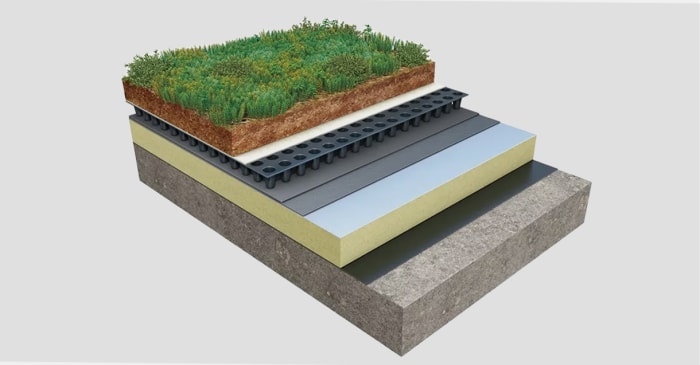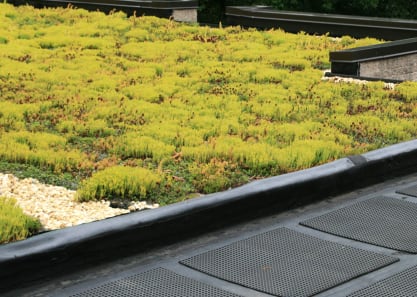
How is a living roof constructed?
- Read time: 5 minutes
- Date: 15 Aug 2022
- Living Roof
No. Most existing buildings are not designed to support a living roof, and it’s unlikely you can add one to a new build partway through construction.
But even if a living roof is part of the design, you must install the type of living roof specified because this will affect the depth of the growing medium used. Switching from an extensive roof, which is usually planted with sedums and is not designed for foot traffic to an intensive roof (which looks more like and may be used as a roof garden) will increase the weight placed on the structure – weight it may not be able to support.
If you’re not sure, always check with the building designer that the building structure can support a living roof.
How is a flat living roof constructed?
There are two main build-ups for a living roof on a flat roof, a warm roof and an inverted warm roof. These are typically made up of the following components.
Warm roof:
Sedum for green roof
Soil
Drainage layer – egg box system (retains water)
Root barrier membrane
Waterproof membrane
Insulation
AVCL
Deck

Inverted warm roof:
Plants
Growing medium
Filter fleece
Drainage layer
Protection layer / root barrier
Insulation
Membrane protection / root barrier
Roofing membrane
Structural deck
Fire break
Can a living roof be planted on a pitched roof?
Yes, it is possible to install a living roof on a pitched roof, although this is much more common in Scandinavian countries than it is in the UK. A well-engineered retention system must be used to support the growing material. Without this, the soil may slip down the roof allowing water to pool at the bottom of the roof. In severe cases, the living roof can slide off completely, putting lives and property below in danger.
How do I create a fire break on a living roof?
The GRO Green Roof Code of Best Practice states that:
To prevent the spread of fire into, or from a building on to the green roof, a fire break of 300mm width is required around all perimeters and penetrations i.e. rooflights, soil pipes, rainwater outlets etc. The fire break should be increased to 500mm where there are openings to the building (such as doors, windows and opening roof lights etc). On large roofs, a one metre wide fire break should be installed at 40 metre intervals across the roof
A fire break must consist of 20 - 50mm size rounded pebbles (fines free) to a minimum depth of 50mm placed directly onto the drainage board, or concrete paving stones that are minimum 40mm thick. There should be no substrate within the fire break area. To help maintain the fire break, a retention angle should be included between the growing medium and the pebble margin/ paving.
Edge protection should also be installed to retain plants and ensure the fire break is not compromised by plants. Always use adhesive to bond the stones together to ensure that stones are not washed into the drainage system or off the roof.
Are there any codes of practice for living roofs?
Yes, the GRO Green Roof Code of Best Practice has been published by the Green Roof Organisation (GRO) to establish best practice in the design, selection of materials, installation and maintenance of green roof systems. It includes references to relevant European and British Standards where appropriate. It does not cover roof design or installation.






